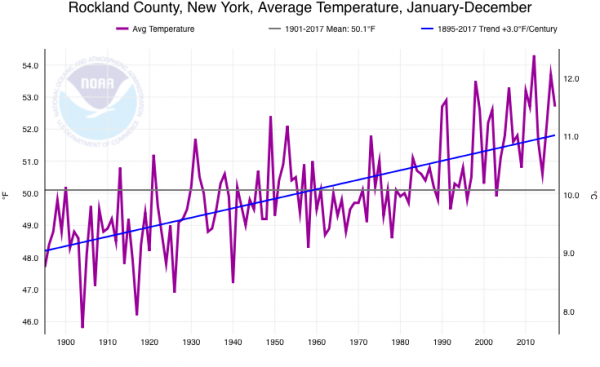by Susan Hellauer
 Earth Matters focuses on conservation, sustainability, recycling and healthy living. This weekly series is brought to you by Maria Luisa Boutique and Strawtown Studio and Blue Rock School and Dying To Bloom, a natural burial boutique for humans and pets. Strawtown Studio invites you to their Illuminations! Community Crafting Event on December 8 and 9.
Earth Matters focuses on conservation, sustainability, recycling and healthy living. This weekly series is brought to you by Maria Luisa Boutique and Strawtown Studio and Blue Rock School and Dying To Bloom, a natural burial boutique for humans and pets. Strawtown Studio invites you to their Illuminations! Community Crafting Event on December 8 and 9.If Earth Matters to you, sign up for our mailing list and get the next installment delivered right to your inbox.
It was a dark and stormy night. Stinky, too. That night followed a daylong downpour last September 26. Nyack resident John Gromada braved the deluge to witness one of Nyack’s messy, rain-induced sanitary sewer overflows (SSO) at the Spear Street pumping station. He found maintenance trucks illuminating the scene, as a fountain of rainwater and raw sewage bubbled up from manhole covers, ran in sheets across the pavement and parking lot, and sloshed down into the Hudson River at the Nyack Marina. “The untreated sewage comes up in the parking lot right at the bottom of the stairs where Spear St. ends,” he wrote in a Nyack Development Watch Facebook post.
Gromada chatted briefly with the workers there as they did their best to contain the mess. They mentioned a number of frustrating issues, including sewage pipe choke points, and equipment malfunctions at the station tasked with pumping raw sewage uphill from Nyack to the Orangetown wastewater treatment plant on Route 303 in Orangeburg. But the culprit was the usual suspect: infiltration and inflow, or “I&I” in sewer lingo.
SSO and I&I 101
What can causes SSO? Problems can occur when what we flush, dump, and pour down the drain reaches a pump station on its way to the wastewater treatment plant. The pump can stop working because of electrical or mechanical failure. It can get blocked by rags, especially baby wipes and so-called “flushable” wipes, which plague sewer systems everywhere. Then there’s kitchen grease, which cools, congeals, and forms notorious “fatbergs” that gum up the pump.

Sewage overflow at the Spear Street pumping station on the night of September 26, 2018. Photo: John Gromada
But the most common cause of SSO is rainwater inflow and infiltration (I&I) into the sanitary sewer during unusually heavy rainstorms and floods. The pump station is overwhelmed with many times the capacity of liquid it can handle, and the incoming rush of sewage-plus-rainwater flows out of the station either through an outfall pipe or up out of a manhole.
How does rain or floodwater get into a supposedly closed sanitary sewer system like Nyack’s, which is meant to keep sewage and storm water apart? Here’s how the U.S. EPA describes I&I:
Infiltration – Water other than sanitary wastewater that enters a sewer system from the ground through defective pipes, pipe joints, connections, or manholes. Infiltration does not include inflow.
Inflow – Water other than sanitary wastewater that enters a sewer system from sources such as roof leaders, cellar/foundation drains, yard drains, area drains, drains from springs and swampy areas, manhole covers, cross connections between storm sewers and sanitary sewers, and catch basins. Inflow does not include infiltration.
Source: U.S. EPA
Whence the Nyack sewage geysers?
Rain-caused sewage overflows in Nyack are nothing new. But seeing toilet paper and what-all geyser up from manholes at our picturesque waterfront is a relatively recent thing. Until last year, SSOs at the Spear Street Station, whether from rain or other problems, flowed into an outfall pipe that discharged into the Hudson River. What changed?
The Town of Orangetown operates and maintains Nyack’s sewer system, so to get the lowdown, Earth Matters met with Orangetown Supervisor Chris Day and, from the town’s Dept. of Environmental Management and Engineering, Commissioner Eamon Reilly and Chief Operator Michael Weber. Nyack Mayor Don Hammond joined us for the November 2 meeting at the Town Hall.
It turns out that Nyack’s permit for an outfall pipe was rescinded by the N.Y. State Department of Environmental Conservation (DEC) in 2017. It was the last—and largest—of the river village outfall pipes to be blocked by the order of the DEC, according to Michael Weber. Why? The DEC is trying to get municipalities to attack the problem of SSOs caused by I&I. “In my world, I’d like to attack the infiltration problem first, and then seal off the outfall pipe, but that’s not the DEC’s vision,” Weber said. “Their mandate says do it now.”
Maybe the DEC has a point. The sight of untreated sewage cascading just yards from Nyack’s waterfront restaurants does keep the problem right in front of our eyes—and under our noses. That’s a great incentive to come up with something, and fast. In fact, a DEC spokesman told Earth Matters that such SSOs over land and into a river are, in fact, prohibited by the federal Clean Water Act and state law. “The [Orangetown Sewer District #2] . . . is under an enforcement order with DEC to eliminate all SSOs to protect public health and water quality,” he said.
What’s up, underground?
When it comes to those annoying blockages, Michael Weber touts a Monday-thru-Friday patrol to suck up the stuck stuff. “Some places are known trouble spots that we attack regularly with our four pressure-cleaning trucks. Then we go through and jet the lines in the entire collection system,” he said.

Orangetown crews clean sewer lines to prevent blockages. Photo: Michael Weber
Those large trucks working on sewer lines in Nyack for the last few years were applying slip-linings, sealing pipes internally to keep storm water from infiltrating through cracks and joints. Despite that work, there have been five rain-caused overflow events this year alone. But Supervisor Day was sure that, without the linings, we’d have seen a lot more. “In 2014, the year the project started, there were five overflow events in a year with substantially less rain. The next three years had comparable levels of rain to 2014, but only had one overflow event each year.” Day went on to point out that this year has been the wettest year of the last seven, and the second wettest in a decade, yet there have only been five SSO events thus far. “There has definitely been an effect, but not a 100% fix, which is why other efforts continue.”

Rainfall figures are from the West Nyack monitoring station, with missing data extrapolated from nearby stations, as reported by Cornell University’s Northeast Regional Climate Center.
Big bang for your engineering buck
Slip linings have now been installed on the leakiest identified pipes, and the next phase of the I&I abatement effort is underway. “We’re checking the bigger properties in Nyack, the ones with large sewer hookups,” said Eamon Reilly. Incorrect hookups in one of these big buildings could be letting storm water run into their laterals and into the sewer system. That’s one big stream of I&I that can be stopped at once, and perhaps stop the SSOs. “That would give us more bang for our buck, rather than trying to find all the little leaky pipes on every street,” said Mike Weber. He described the next options and their hefty price tags: an overflow basin “in the millions of dollars,” or relining and replacing every pipe. “And no one even knows where all of Nyack’s sewer pipes are,” he added.
Orangetown engineers are already working with Nyack Hospital and the Claremont Condominiums, pouring bright nontoxic dye on their roofs during heavy rainstorms to help trace a storm water-caused overflow back to its sources. Supervisor Chris Day has just reported some positive results to EM: “Our team did find some infiltration at the older section of Nyack Hospital during the last overflow event and are working with the hospital to get that addressed,” he said. There haven’t been any SSOs since then, he noted, but dye testing will be done in heavy rainstorms “so that we can continue to stop this form of infiltration.”

A bilious green Nyack Brook on Main Street shocked villagers recently. It was all a (nontoxic) part of dye testing to find sources of I&I in SSOs. Photo: Dr. Kristina Wodicka via Village of Nyack Facebook group
Closer to home
There was a time, long ago, Weber explained, when it was fine for downspouts or sump pumps to carry rainwater into the sewer system. But not anymore. That water now must be directed to a street storm sewer, or discharged onto the property or into a catch basin for saturation back into the ground. “It would be a herculean task to inspect every property in the town, which is why we’re going after the big properties first,” said Reilly.
Nevertheless, Nyack Mayor Don Hammond noted that the village is discussing this aspect of the problem right now. “The planning board and building department are going to be reviewing our codes, and building this into our inspection process for building permits or certificates of occupancy,” he said.
For a clean village and a clean river, and no more stinky messes for people or fish, it’s clear that cooperation between village and town, and plenty of persistence, will be needed “That’s why we met with the Town of Orangetown and their sewer department,” said Hammond. “We’ve got an issue here, and we’ll figure out what we can do together to solve it. The most important thing is that we are working on this problem and we are all equally motivated to work together and solve it.”


There’s no question that wastewater and sewer engineers in our region will have to run to keep up with the rain. A warmer atmosphere holds more moisture, as we’ve seen in recent monster storms with record setting rainfall. Graphs show annual averages of temperature and precipitation in Rockland County. Chart: NOAA “Climate at a Glance”
Learn more:
- Riverkeeper’s campaign against sewage pollution
- Sanitary Sewer Overflow (SSO) frequently asked questions (US EPA)
-
The Sewage Pollution Right to Know Law means that you can sign up with NY Alerts to receive sewage discharge notifications for any area in NY State with a text message or email.
-
Since 2013, the Sewage Pollution Right to Know Law has mandated that the DEC collect overflow data from sewer systems around that state. You can find these reports at their Sewage Pollution Right to Know webpage.
- “A Sewage-Free Hudson? Working On It” (8/22/18, Nyack News and Views)
Read Earth Matters every Wednesday on Nyack News And Views, or sign up for the Earth Matters mailing list.
Earth Matters, a weekly feature that focuses on conservation, sustainability, recycling and healthy living, is sponsored by Maria Luisa Boutique, Dying to Bloom, Strawtown Studio, and Blue Rock School.












